wheel Acura RSX 2002 Owner's Manual
[x] Cancel search | Manufacturer: ACURA, Model Year: 2002, Model line: RSX, Model: Acura RSX 2002Pages: 320, PDF Size: 4.38 MB
Page 8 of 320

This section gives you important
inf ormation about how to protect
yourself and your passengers. It
shows you how to use seat belts
properly. It explains your Supple-
mental Restraint System. And it tells
you how to properly restrain inf ants
andchildreninyourcar..........
Important Safety Precautions . 6
.............
Your Car’s Saf ety Features . 7
.......................................
Seat Belts .8
.........................................
Airbags .10
.....................
Seats & Seat-Backs .11
..........................
Head Restraints .11
..................................
Door Locks .11
........
Pre-Drive Saf ety Checklist . 12
............................
Protecting Adults .13
.....
1. Close and Lock the Doors . 13 ...........
2. Adjust the Front Seats . 13
............
3. Adjust the Seat-Backs . 14
4. Fasten and Position the Seat .....................................
Belts .16
....
5. Adjust the Steering Wheel . 17
6. Maintain a Proper Sitting ................................
Position .18
.....
Advice f or Pregnant Women . 19
...
Additional Safety Precautions . 19
........................
Protecting Children .21
All Children Must Be ...............................
Restrained .21
Children Should Sit in the Back ...........................................
Seat .22
The Passenger’s Front Airbag Poses Serious Risks to ...............................
Children .22
If You Must Drive with Several ...................................
Children .24
If a Child Requires Close ..................................
Attention .24
...
Additional Safety Precautions . 25
General Guidelines f or Using ...............................
Child Seats .26
.......................
Protecting Inf ants .30
.........
Protecting Small Children . 34 .......
Protecting Larger Children . 37
Using Child Seats with .....................................
Tethers .41
.............................
Using LATCH .42
Additional Inf ormation About Your .................................
Seat Belts .44
..
Seat Belt System Components . 44
......................
Lap/Shoulder Belt .44
Automatic Seat Belt ...............................
Tensioners .45
...............
Seat Belt Maintenance . 46
Additional Inf ormation About ...........................
Your Airbags .48
........................
SRS Components .48
How Your Front Airbags .........................................
Work .48
...
How Your Side Airbags Work . 50
How the SRS Indicator Light .......................................
Works .51
How the Side Airbag Cut-of f ...........
Indicator Light Works . 52
.............................
Airbag Service .53
...
Additional Safety Precautions . 53
.............
Carbon Monoxide Hazard . 54
...................................
Saf ety Labels .55
Driver and Passenger Saf ety
Driver and Passenger Saf ety
5
Page 13 of 320
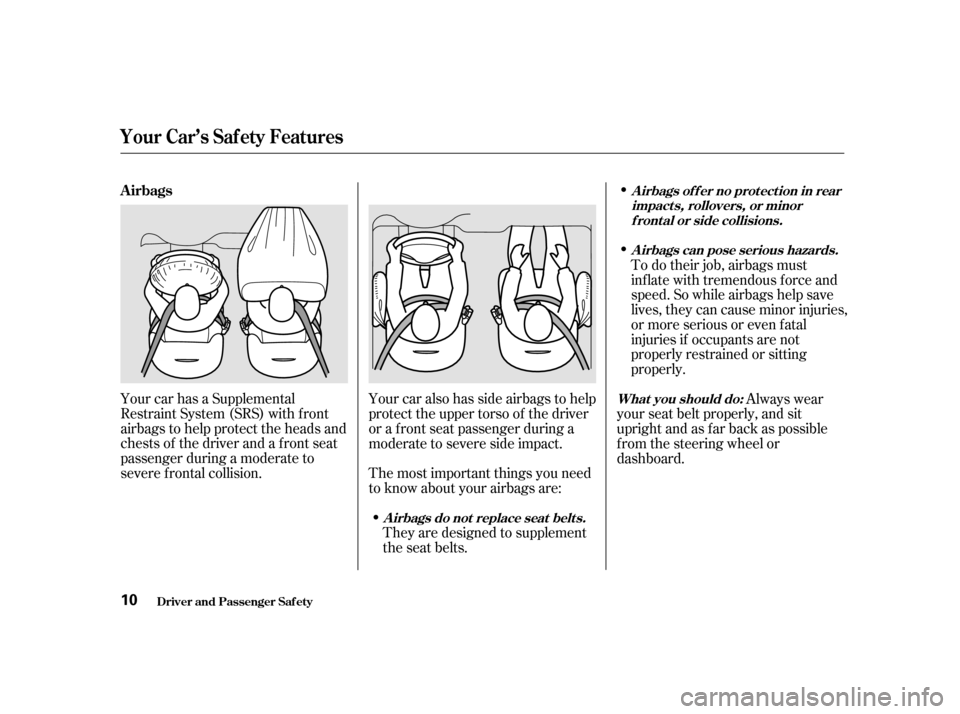
Your car has a Supplemental
Restraint System (SRS) with f ront
airbags to help protect the heads and
chests of the driver and a front seat
passenger during a moderate to
severe f rontal collision.Your car also has side airbags to help
protect the upper torso of the driver
or a f ront seat passenger during a
moderate to severe side impact.
The most important things you need
to know about your airbags are:
They are designed to supplement
the seat belts. To do their job, airbags must
inf late with tremendous f orce and
speed. So while airbags help save
lives, they can cause minor injuries,
or more serious or even fatal
injuries if occupants are not
properly restrained or sitting
properly.
Always wear
your seat belt properly, and sit
upright and as f ar back as possible
f rom the steering wheel or
dashboard.
Airbags
Your Car’s Saf ety Features
Driver and Passenger Saf ety
Airbags do not replace seat belts. A irbags of f er no prot ect ion in rear
impact s, rollovers, or minorf ront al or side collisions.
Airbags can pose serious hazards.
What you should do:
10
Page 14 of 320

How you adjust your seats and seat-
backs can also affect your safety. For
example, sitting too close to the
steering wheel or dashboard
increases the risk of you or your
passenger being injured by striking
theinsideof thecar,orbyan
inf lating airbag.
Reclining a seat-back too f ar reduces
the seat belt’s ef f ectiveness and
increases the chance that the seat’s
occupant will slide under the seat
belt in a crash and be seriously
injured. Your car’s seats are designed to keep
you in a comf ortable, upright
position so you can take f ull
advantage of the protection offered
by seat belts and the energy
absorbing materials in the seats.Move the f ront
seats as far back as possible, and
keep adjustable seat-backs in an
upright position whenever the car is
moving. Keeping your doors locked reduces
thechanceof beingthrownoutof
the car during a crash. It also helps
prevent occupants f rom accidentally
opening a door and f alling out, and
outsiders f rom unexpectedly opening
your doors.
Head restraints can help protect you
f rom whiplash and other injuries.
Seats & Seat-Backs
Door L ocks
Head Restraints
What you should do:
Driver and Passenger Saf ety
Your Car’s Saf ety Features
11
Page 15 of 320

All adults, and children who have
outgrown child saf ety seats, are
wearing their seat belts and
wearingthemproperly(seepage).
Any inf ant or small child is
properly restrained in a child seat
inthebackseat(seepage ).
To make sure you and your
passengers get the maximum
protection f rom your car’s saf ety
f eatures, check the f ollowing each
time before you drive away:
The rest of this section gives more
detailed inf ormation about how you
can maximize your saf ety.
Remember, however, that no saf ety
system can prevent all injuries or
deaths that can occur in severe
crashes, even when seat belts are
properly worn and the airbags deploy.
Seat-backs are upright (see page
).
Frontseatoccupantsaresitting
upright and as f ar back as possible
f rom the steering wheel and
dashboard (see page ).
All cargo is properly stored or
secured (see page ). Both doors are closed and locked
(see page ).
16
21 13
14
13164
Pre-Drive Saf ety Checklist
Your Car’s Saf ety Features
Driver and Passenger Saf ety12
Page 16 of 320
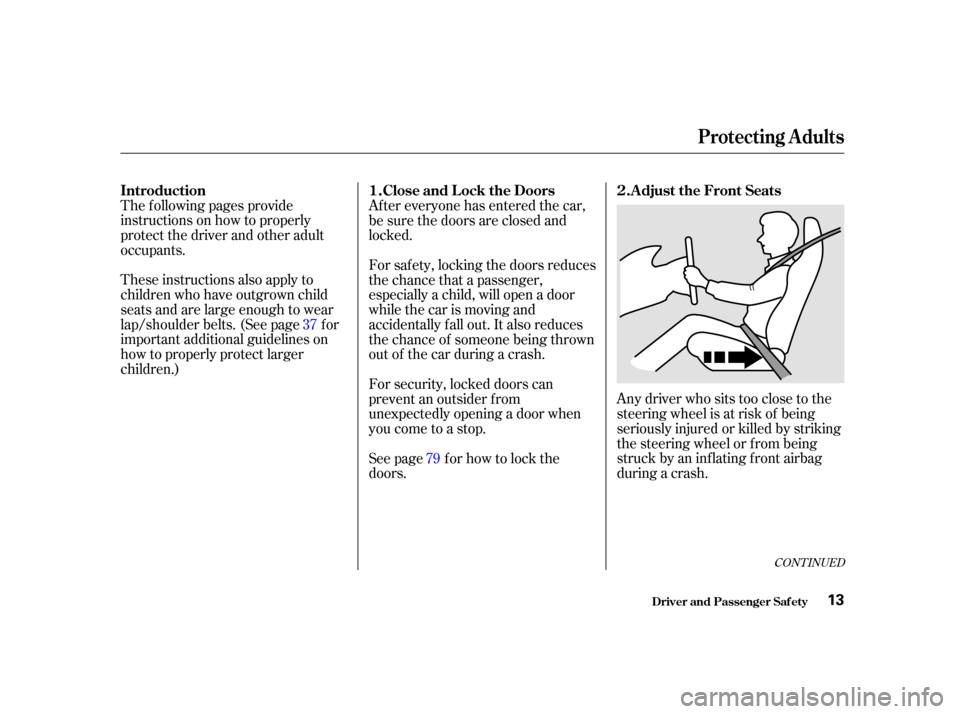
The f ollowing pages provide
instructions on how to properly
protect the driver and other adult
occupants.
These instructions also apply to
children who have outgrown child
seats and are large enough to wear
lap/shoulder belts. (See page f or
important additional guidelines on
how to properly protect larger
children.)Any driver who sits too close to the
steering wheel is at risk of being
seriously injured or killed by striking
the steering wheel or f rom being
struck by an inflating front airbag
during a crash.
Af ter everyone has entered the car,
be sure the doors are closed and
locked.
For saf ety, locking the doors reduces
the chance that a passenger,
especially a child, will open a door
while the car is moving and
accidentally f all out. It also reduces
the chance of someone being thrown
out of the car during a crash.
For security, locked doors can
prevent an outsider f rom
unexpectedly opening a door when
you come to a stop.
See page f or how to lock the
doors.
37
79
CONT INUED
Introduction A djust the Front Seats
Close and L ock the Doors
1. 2.
Protecting Adults
Driver and Passenger Saf ety13
Page 17 of 320

To reduce the chance of injury, wear
your seat belt properly, sit upright
with your back against the seat and
movetheseatawayfromthe
steering wheel to the f arthest
distance that allows you to maintain
f ull control of the car.
The National Highway Traffic Safety
Administration and Transport
Canada recommend that drivers
adjust the seat so the center of the
chest is at least 10 inches away f rom
the center of the steering wheel.
Also make sure your f ront seat
passenger moves the seat as f ar to
the rear as possible.Adjust the driver’s seat-back to a
comf ortable, upright position,
leaving ample space between your
chest and the airbag cover in the
center of the steering wheel. If you
sit too close to the steering wheel,
you could be injured if the f ront
airbag inflates.
Most shorter drivers can get f ar
enough away f rom the steering
wheel and still reach the pedals.
However, if you are concerned about
sitting too close, we recommend that
you investigate whether some type
of adaptive equipment may help.
Once your seat is adjusted correctly,
rock it back and f orth to make sure
the seat is locked in position.
See page f or how to adjust the
f ront seats. 86
Protecting Adults
Driver and Passenger Saf ety
Adjust the Seat-Backs
3.
14
Sitting too close to a front
airbag can result in serious
injury or death if the front
airbags inflate.
Always sit as far back from the
front airbags as possible.
Page 20 of 320
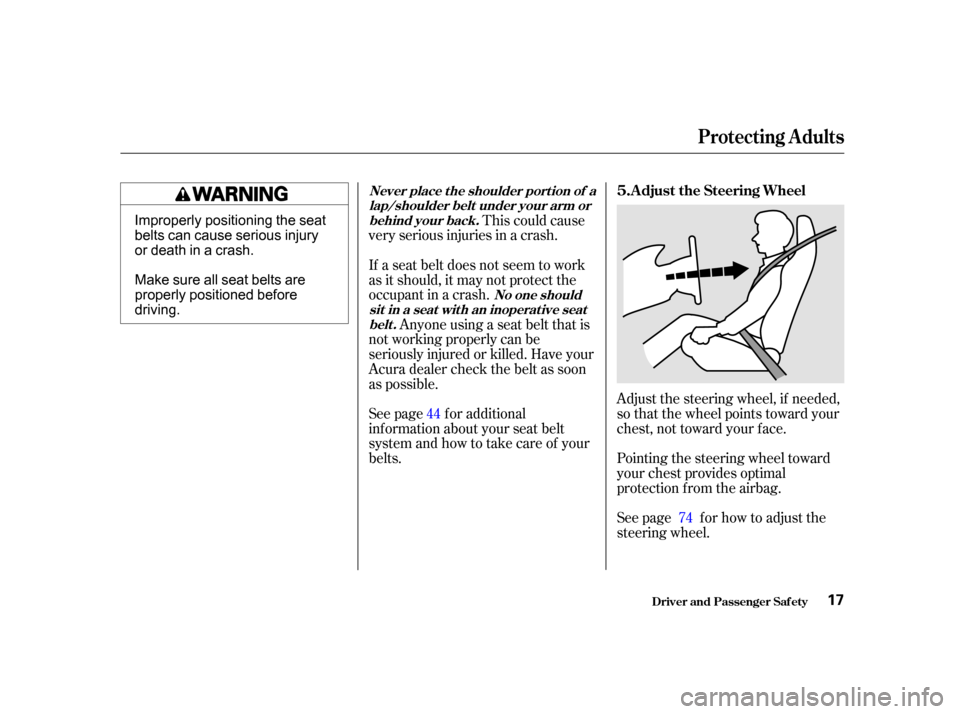
Adjust the steering wheel, if needed,
so that the wheel points toward your
chest, not toward your f ace.
Pointing the steering wheel toward
your chest provides optimal
protection f rom the airbag.
See page f or how to adjust the
steering wheel.
See page f or additional
inf ormation about your seat belt
system and how to take care of your
belts. This could cause
very serious injuries in a crash.
If a seat belt does not seem to work
as it should, it may not protect the
occupant in a crash.
Anyone using a seat belt that is
not working properly can be
seriously injured or killed. Have your
Acura dealer check the belt as soon
as possible.
44
74
A djust the Steering Wheel
5.
Protecting Adults
Driver and Passenger Saf ety
Never place t he shoulder port ion of a
lap/shoulder belt under your arm orbehind your back.
No one should
sit in a seat wit h an inoperat ive seat belt.
17
Improperly positioning the seat
belts can cause serious injury
or death in a crash.
Make sure all seat belts are
properly positioned before
driving.
Page 22 of 320
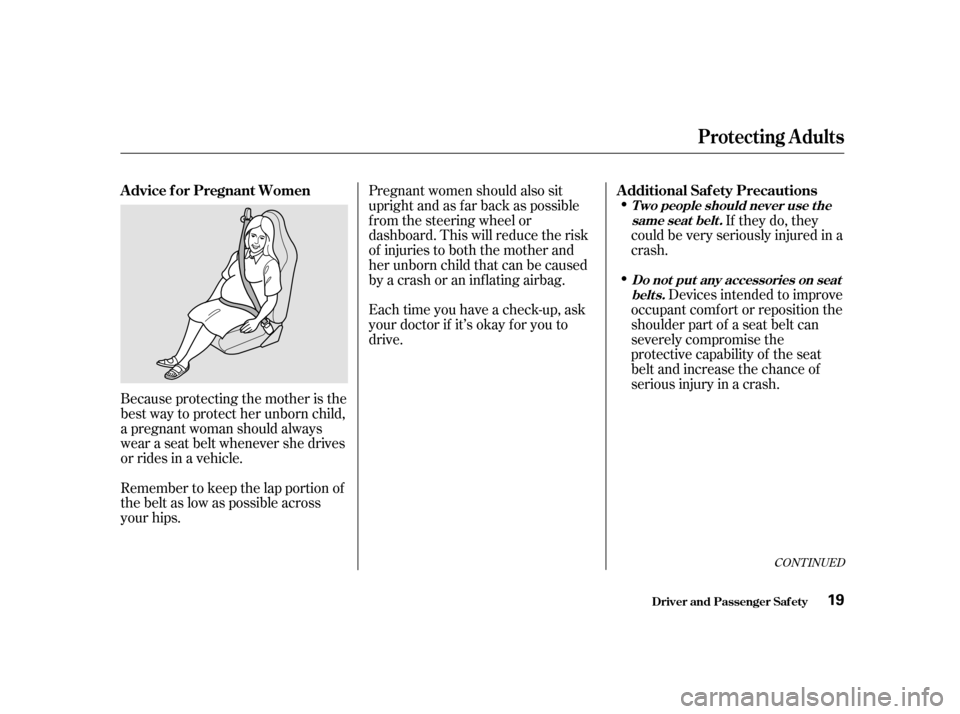
Because protecting the mother is the
best way to protect her unborn child,
a pregnant woman should always
wear a seat belt whenever she drives
or rides in a vehicle.
Remember to keep the lap portion of
the belt as low as possible across
your hips.Pregnant women should also sit
upright and as f ar back as possible
f rom the steering wheel or
dashboard. This will reduce the risk
of injuries to both the mother and
her unborn child that can be caused
by a crash or an inf lating airbag.
Each time you have a check-up, ask
your doctor if it’s okay f or you to
drive.
If they do, they
couldbeveryseriouslyinjuredina
crash.
Devices intended to improve
occupant comf ort or reposition the
shoulder part of a seat belt can
severely compromise the
protective capability of the seat
belt and increase the chance of
serious injury in a crash.
CONT INUED
Protecting Adults
Driver and Passenger Saf ety
Advice f or Pregnant Women Additional Saf ety Precautions
T wo people should never use t he
same seat belt .
Do not put any accessories on seatbelts.
19
Page 23 of 320

Carrying hard or sharp
objects on your lap, or driving with
a pipe or other sharp object in
your mouth, can result in injuries
if your f ront airbag inf lates.
Any object
attached to or placed on the covers
marked ‘‘SRS AIRBAG’’ in the
center of the steering wheel and
on top of the dashboard could
interf ere with the proper operation
of the airbags. Or, if the airbags
inf late, the objects could be
propelled inside the car and hurt
someone. If a side airbag
inflates,acupholderorotherhard
object attached on or near the
door could be propelled inside the
car and hurt someone.
If your
hands or arms are close to the
airbag cover in the center of the
steering wheel or on top of the
dashboard, they could be injured if
the f ront airbags inf late.
Protecting Adults
Driver and Passenger Saf ety
Do not place hard or sharp object s
bet ween yourself and a f rontairbag.
Do not at t ach or place object s onthe f ront airbag covers. Do not at t ach hard object s on or
near a f ront door.
K eep your hands and arms awayf rom t he airbag covers.
20
Page 51 of 320
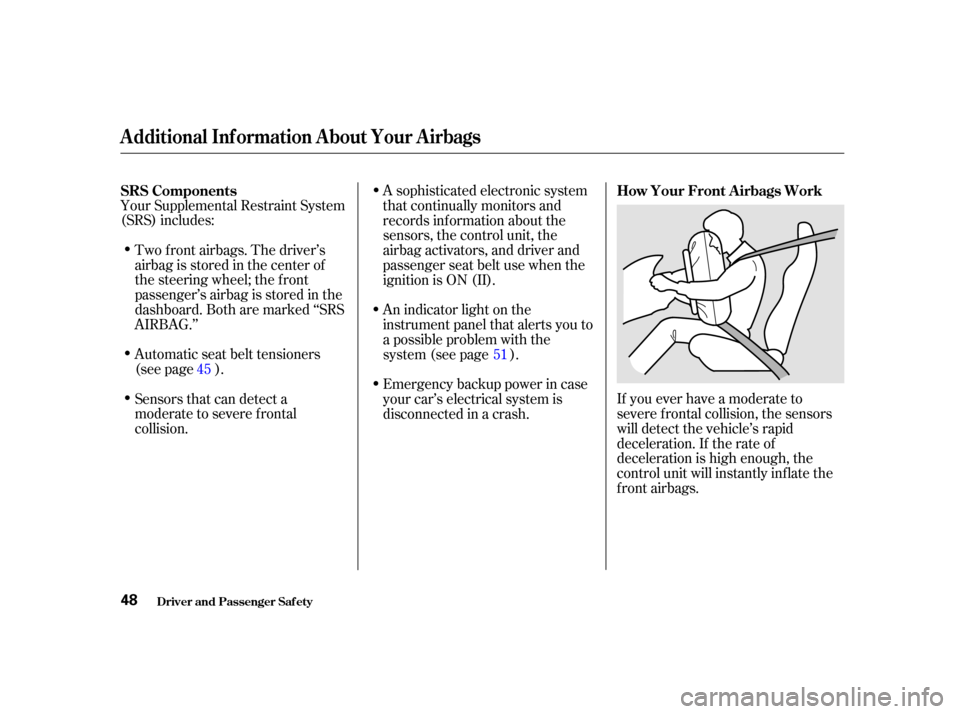
Your Supplemental Restraint System
(SRS) includes:Two f ront airbags. The driver’s
airbag is stored in the center of
the steering wheel; the f ront
passenger’sairbagisstoredinthe
dashboard. Both are marked ‘‘SRS
AIRBAG.’’
If you ever have a moderate to
severe f rontal collision, the sensors
will detect the vehicle’s rapid
deceleration. If the rate of
deceleration is high enough, the
control unit will instantly inf late the
f ront airbags.
A sophisticated electronic system
that continually monitors and
records inf ormation about the
sensors, the control unit, the
airbag activators, and driver and
passenger seat belt use when the
ignition is ON (II).
Sensors that can detect a
moderate to severe frontal
collision. Automatic seat belt tensioners
(see page ). An indicator light on the
instrument panel that alerts you to
a possible problem with the
system (see page ).
Emergency backup power in case
your car’s electrical system is
disconnected in a crash.
45
51
SRS Components
How Your Front A irbags Work
Additional Inf ormation About Your Airbags
Driver and Passenger Saf ety48